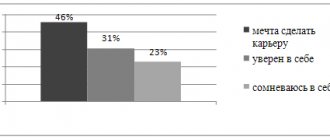Lev Semenovich Vygotsky developed a fundamental theory of the formation and development of higher, specifically human mental functions in a child. Vygotsky’s main idea is about the social mediation of human mental activity. The instrument of this mediation is, according to Vygotsky, a sign (word).
His concept is called “cultural-historical” because, according to this concept, the child’s consciousness, the specific features of his higher mental functions (voluntary memory, voluntary attention) are formed in the child in communication with adults, in which the child assimilates systems of cultural signs developed in the process of socio-historical development. These signs mediate his “lower” (involuntary) mental functions and thereby lead to the creation of completely new formations in the child’s mind.
The main provisions of Vygotsky’s theory on the development of higher mental functions (HMF)
lines of development in human development :
- The natural developmental line is the physical, natural development of a child from the moment of birth.
- Cultural (historical) line of development - arises with the emergence of communication with the outside world.
In the conditions of ontogenetic development, both of these lines - biological and cultural - are in complex interaction, merged, and actually form a single, albeit complex process.
Classification of mental functions
- Lower (elementary) mental functions (LPF) are natural: sensations, perception, children's thinking, involuntary memory.
- Higher mental functions (HMF) are complex, intravitally developing mental processes, social in origin. The distinctive features of HMF are their indirect nature and arbitrariness. These include abstract thinking, speech, voluntary memory, voluntary attention, and imagination.
The child’s higher mental functions arise initially as a form of collective behavior, as a form of cooperation with other people, and only subsequently, through internalization, do they become individual functions themselves, or, as L.S. Vygotsky wrote: “Every function in the cultural development of a child appears on the scene twice, on two levels, first social, then psychological, first between people, as an interpsychic category, then within the child as an intrapsychic category.” The process of formation of the highest mental function is extended over a decade, originating in verbal communication and ending in full-fledged symbolic activity.
Lower mental processes
Mechanical memory is one of the types of natural or lower psychological processes. Information is remembered directly in the form in which it is presented, that is, the form of information is memorized directly. The neural connections of the first signaling system provide human mechanical memory. The logical and semantic content of the information remains in the shadows.
Finished works on a similar topic
Course work Higher and lower mental processes 430 ₽ Abstract Higher and lower mental processes 270 ₽ Test work Higher and lower mental processes 190 ₽
Receive completed work or specialist advice on your educational project Find out the cost
Involuntary attention compared to voluntary attention is a lower form of attention. It occurs when one of the analyzers is affected by a certain stimulus. The stimulus may arise unexpectedly, may have a strong impact, and the novelty of the stimulus also affects the mechanism of involuntary memory formation. The causes of involuntary attention include the internal state of a person.
Reproducing imagination in its essence is visual memory. When this process works, a person reproduces a number of images that we have experienced, but they arise spontaneously. An image can be represented by objects, phenomena, and actions. The reproducing imagination is also called reproductive.
The role of the environment in child development
Vygotsky was the first to move from a statement about the importance of the environment for development to identifying a specific mechanism of environmental influence, which actually changes the child’s psyche, leading to the emergence of higher mental functions specific to a person. Vygotsky considered such a mechanism to be the internalization of signs – artificially created man-made incentives and means designed to control one’s own and others’ behavior. HPFs arose with the help of a sign.
Signs are mental tools that, unlike tools of labor, change not the physical world, but the consciousness of the subject operating them. A sign is any conventional symbol that has a specific meaning. The universal sign is the word. The mechanism of change in the child’s psyche, which leads to the emergence of higher mental functions specific to a person, is the mechanism of internalization (appropriation) of signs as a means of regulating mental activity.
Signs, being a product of social development, bear the imprint of the culture of the society in which the child grows up. Children learn signs in the process of communication and begin to use them to manage their inner mental life. Thanks to the internalization of signs, the sign function of consciousness is formed in children, and the formation of such higher mental functions as logical thinking, will, and speech occurs. The use of a sign, a word as a specifically human mental regulator reconstructs all higher mental functions of a person. Mechanical memory becomes logical, the associative flow of ideas becomes productive thinking and creative imagination, impulsive actions become voluntary actions.
Relationship between training and development
Development is a process of quantitative and qualitative changes in the body, nervous system, psyche, and personality. Education is a process of purposeful transfer of socio-historical experience, organization of the acquisition of knowledge, skills and abilities.
Vygotsky identified and summarized the following most widely accepted points of view on the question of the relationship between training and development:
- Training and development are two processes independent from each other . Development is considered as a process that occurs according to the type of maturation, and learning is considered as a purely external use of development opportunities. Training is built on top of development and does not change anything in essence. When analyzing mental development, they try to separate what comes from development and what comes from learning.
- Training and development are two identical processes . A step in learning corresponds to a step in development. A child is only as developed as he is trained.
- Training and development are closely related processes . Development is understood dualistically: there is development as maturation and there is development as learning. On the one hand, development is thought of as a process independent of learning. On the other hand, learning, during which the child acquires new forms of behavior, is identified with development. Development (maturation) prepares and makes possible the learning process, and learning, as it were, stimulates the development (maturation) process. The processes of learning and development are separated, and at the same time their relationship is established.
Vygotsky contrasts these theories with his own, according to which learning and development are not two independent processes or the same process; there is “unity, but not identity, of the learning processes and internal development processes.” According to Vygotsky, it is neither correct to identify the processes of learning and development, nor to assume that the development process occurs independently of the learning process. He argues that there is a complex relationship between learning and development.
Zone of Proximal Development (ZPD)
To explain the question of the influence of learning on development, Vygotsky introduced the concept of two levels of child development :
- The zone of actual development is the level of development already achieved by the child. This is the level of intellectual tasks that he is able to solve completely independently, without the help of an adult. The level of the child’s actual development shows us what mental processes have already developed in him, i.e. in fact, by its current development we can judge the already completed development cycles.
- Zone of Proximal Development (ZPD) . It is revealed not in the child’s independent, but in joint problem solving with adults. The second level is higher than the first, since with the help of an adult the child is able to solve more complex problems. These are discrepancies between the level of actual development (it is determined by the degree of difficulty of problems solved by the child independently) and the level of potential development (which the child can achieve by solving problems under the guidance of an adult and in collaboration with peers). The ZPD defines mental functions that are in the process of maturation. ZPD is a consequence of the formation of higher mental functions, which are formed first in joint activity, in cooperation with other people, and gradually become internal mental processes of the subject.
Vygotsky made the following conclusions: 1) learning creates a zone of proximal development, which then moves into the sphere of actual development; 2) learning moves development forward, relying not only on mature functions, but also on those that are still maturing. Education must come before development. And therefore Vygotsky makes the main conclusion: pedagogy should focus not on yesterday’s, but on tomorrow’s development (i.e., on the child’s zone of proximal development). What a child does today in collaboration with an adult, tomorrow he will do independently. Thus, training and upbringing play a leading role in the mental development of a child.
Lecture “Human Psyche. Functions of the psyche"
PSYCHE
Plan:
- The concept of the psyche
- Functions of the psyche
- Disturbance of Consciousness
Literature:
- Vygotsky L.S. Psychology. –M.: Publishing house EKSMO-Press, 2010.
- Danilova N.N., Krylova A.L. Physiology of higher nervous activity: textbook. University with a degree in Psychology. –M.: Moscow State University Publishing House, 2009.
- Leontyev A.N. Selected psychological works: In 2 volumes. T.2. /Ed. V.V. Davydova et al. – M.: Pedagogy, 2008.
- Maklakov A.G. General psychology. – St. Petersburg, 2008.
1. The concept of the psyche. Functions of the psyche.
We feel tastes, smells, see objects, experience emotions. Some of us have an absolute ear for music, others have a good memory; Some enjoy walking, others enjoy reading books. Why can we experience and feel something, why are we so different from each other? Something gives us all these opportunities. This is our psyche. It is the properties and functions of the human psyche that provide us with everything we see, hear, feel, and how we behave.
The psyche is given to a person from birth, but develops in the process of life. It develops depending on the experience gained and circumstances. We need the psyche to receive, combine, understand information about the world around us, compare it with our needs and develop the necessary behavior. The basic functions of the psyche provide a person with adaptation to different conditions, the ability to communicate, learn, and, if the need arises, to survive. All functions are closely related and interdependent, therefore the normal psyche is holistic, they ensure the interaction of a person with the environment.
Psyche is a reflection of reality by the brain, manifesting itself in a person in the form of mental phenomena.
All mental phenomena are divided into three groups:
1) mental processes;
2) mental states;
3) mental properties of the individual.
Mental processes
are divided into:
1) cognitive (sensation, perception, thinking, memory and imagination);
2) emotional;
3) strong-willed.
Mental conditions
are divided into: 1)
motivational
- desires, interests, drives, passions;
2) states of organized consciousness
(manifested in various levels of attentiveness and efficiency);
3) emotional
(emotional tone of sensations, emotional response to reality, mood, conflicting emotional states - stress, affect, frustration);
4) volitional
(states of initiative, purposefulness, determination, perseverance, etc.
Borderline mental states of personality also differ
– psychopathy, character accentuations, neuroses and states of delayed mental development.
Mental states can be short-term, situational and stable, personal.
To psychic properties
personalities include:
1) temperament;
2) personality orientation (needs, interests, worldview, ideals);
3) character;
4) abilities.
This is the traditional classification of mental phenomena, coming from I. Kant. It underlies the construction of traditional psychology. However, this classification suffers from an artificial separation of mental processes from mental states and typological properties of the individual: cognitive, volitional and emotional processes are nothing more than certain mental capabilities (abilities) of the individual, and mental states are the current uniqueness of these capabilities.
2. Functions of the Psyche
- Communicative – provides the opportunity for people to communicate with each other.
- Cognitive – allows a person to understand the outside world around him.
- The regulatory function ensures the regulation of all types of human activity (play, study, work), as well as all forms of his behavior.
Factors of mental development Factors of mental development
it is generally accepted:
- heredity (the ability of an organism to repeat similar types of metabolism and individual development over a number of generations);
- environment (the social, material and spiritual conditions of his existence surrounding a person);
- developmental activity (the active state of the body, manifests itself when the movement programmed by the body towards a certain goal requires overcoming environmental resistance).
There are different points of view regarding the origin of the psyche:
- Idealistic -
the mental (soul) in its origin is not connected with the body (the biological carrier of the soul) and has a divine origin; - Dualistic -
there are 2 principles: mental (ideal) and biological (material). These two principles develop in parallel and are to a certain extent connected with each other. - Materialistically,
the phenomenon of the psyche is due to the evolution of living nature, and its existence should be considered as a property of highly developed matter.
Vygotsky Lev Semyonovich (1896-1934) - Soviet psychologist, author of the work “THE HISTORY OF THE DEVELOPMENT OF HIGHER MENTAL FUNCTIONS.”
Vygotsky L.S. showed that humans have a special type of mental functions that are completely absent in animals. These higher mental functions constitute the highest level of the human psyche and are called consciousness. They are formed during social interactions.
Higher mental functions (voluntary memory, voluntary attention, logical thinking) are of a social nature.
- First conclusion
in the work of Vygotsky L.S. answers the question: “How do relationships with the environment differ between animals and humans?” and it sounds like this:
The environment acts on the animal, modifying it and forcing it to adapt to itself. Man acts on nature and modifies it.
2) Second conclusion
lies in the fact that
a person, having mastered nature, learned to master his own psyche, he acquired higher mental functions, expressed in forms of voluntary activity (only a person is able to force himself to remember the necessary material, to pay attention to something).
3) Third conclusion
lies in the fact that a person tries to master his behavior with the help of psychological tools. (Vygotsky L.S. called them signs).
Signs are
artificial means with the help of which primitive man was able to master his behavior, memory, etc.
The main conclusion of Vygotsky’s concept:
“Man is fundamentally different from animals in that he has mastered nature with the help of tools. This left an imprint on his psyche - he learned to master his own higher mental functions. To do this, he uses psychological tools (signs). The universal and most typical system of signs is speech.”
Four levels of development of the psyche of living organisms
1. Irritability is
a property that distinguishes living matter from dead matter.
Manifests itself in the forced activity of a living organism. The higher the level of development of the organism, the more complex the manifestation of its activity.
Plants have the primary form of irritability (for example: “tropism” - forced movement towards the light).
2. Sensitivity -
characterizes the general ability to sense.
A distinctive feature from irritability is that living organisms have the opportunity to respond not only to biological environmental factors, but also to biologically neutral ones. (Characteristic of more developed organisms: worms, mollusks - the ability to avoid harmful environmental influences).
3. The behavior of higher animals is
a complex set of reactions of a living organism to environmental influences.
The higher the level of development, the more complex his behavior. Learning ability.
4. Human consciousness is
the highest level of mental reflection and regulation, inherent only to humans.
Consciousness acts as a continuously changing set of sensory and mental images that directly appear before the subject in his inner world and anticipate his practical activity.
A person refracts all perceived information about the world around him through a system of ideas about himself and forms his behavior based on values, ideals and motivational attitudes.
Only humans have the highest level of mental consciousness!
CONSCIOUSNESS -
the highest level of mental reflection of reality, manifested by the individual’s ability to be aware of the environment, present and past times, make decisions and manage their behavior in accordance with the situation.
Conscious activity is one of the highest psychological functions. Without the participation of consciousness, it is impossible to imagine any completed complex action.
The disease can change self-awareness, in particular, disrupt the awareness of oneself as a patient or the understanding of oneself as a person, one’s “I”.
3. Impaired Consciousness
In clinical practice, two large groups
pronounced pathological states of consciousness:
- Darkness;
- Shutdown;
1) Clouding of consciousness
includes:
- Delirium-
violation of orientation in place, time and environment, provided that orientation in one’s own personality is maintained.
The appearance of abundant visual and auditory hallucinations, usually of a frightening nature, is typical. The visual image is often various zoopsies (rats, mice, snakes, etc.). These disorders are accompanied by psychomotor agitation: the patient experiences fear, anxiety, tries to defend himself, and flee. The sympathetic nervous system is activated (increased blood pressure, sweating, trembling, tachycardia). In an acute condition, the patient poses a certain danger to others. After leaving the state, a partial memory of the experience is retained. Delirium is most often observed in alcoholism; in everyday life it is classified as “delirium tremens.”
- Amentia (amentive state
ie
) -
observed in severe and long-term illnesses (infections, septicopyemia, etc.).
Orientation in the environment, in time and in one’s own personality is disrupted. The patient does not comprehend his surroundings; his speech consists of fragments of phrases. Often the patient is agitated in bed. The painful condition can last for a long time.
- Oneirod
(dream-like state) - characterized by incomplete, often double, orientation in place, time and one’s own personality. The patient seems to be immersed in a world of dream-like fantastic dreams: he is on other planets, in exotic gardens, etc.
Moreover, he is not the main character, but rather an accomplice, in contrast to the state of delirium, in which the patient empathizes with vivid visual and auditory deceptions, and builds his behavior accordingly.
The facial expressions of patients are characteristic: sometimes they are detached and sad, sometimes they are “enchanted.” The eyes are often closed or half-closed. If you try to make contact with the patient, he can talk about his dreams and at the same time give his name and room number (double orientation). Memories of the experience remain. Patients talk colorfully about the most acute painful disorders. Oneiric disorders of consciousness are observed in acute endogenous psychoses and some infectious diseases.
- Cmoderate state
reminiscent of the state of a person at twilight, when he sees only a small number of dimly lit surrounding objects.
In such states, consciousness seems to slide, attention stops only on individual phenomena. The patient is well oriented in the environment, his self-awareness is changed. Behavior is dominated by automated actions that are outwardly quite orderly. The patient gives the impression of a person deeply immersed in his thoughts and fenced off from his surroundings. Sometimes frightening hallucinatory delusional states develop: the patient runs in fear or attacks imaginary enemies. In such cases, he is dangerous to others.
The twilight state is observed in epilepsy and organic diseases of the brain. The twilight state occurs suddenly and can also end unexpectedly. It usually lasts from several minutes to several hours, less often days. The memory of the experience is not retained.
- State of ambulatory automaticity
also characterized by automated forms of behavior. Awareness of the environment and self-awareness are altered (as in half-asleep). This includes sleepwalking (somnambulism, sleepwalking) and trance - a violation of consciousness, in which the patient can perform purposeful actions, travel by transport during the day, go to another area
The state of ambulatory automatism ends as suddenly as it appeared. If, upon leaving it, the patient finds himself in an unfamiliar environment, then he cannot give himself an account of what happened.
- Disorder of self-consciousness, and
Or
depersonalization is
a painful feeling of alienation of one’s own personality, conscious and painfully experienced by the patient himself.
The body has changed (it has become large, small, heavy, light) and its usual layout (long arms, short torso, excessively large head, etc.)
In the clinic of internal diseases, loss of consciousness is predominantly encountered (from mild to complete).
2)
Switching off consciousness
includes:
- Nullification
(from Lat. pubes - cloud) - mild impairment of consciousness.
Consciousness becomes foggy for a few seconds or minutes, covered with a light cloud. Orientation in the environment and one’s own personality is not disturbed, memories of events after a painful disorder are preserved.
- Somnolence
(drowsiness) - a long-term (hours, days) state resembling drowsiness.
The orientation is not affected. More often this occurs against the background of neurotropic intoxication (poisoning with alcohol, sleeping pills, etc.).
Based on the depth of disturbance of consciousness, coma, stupor and stupor are distinguished.
.
- Stun
- a state of incomplete wakefulness, which is characterized by loss or disturbance of varying degrees of severity of the coherence of thoughts and actions, due to a severe disorder of attention, drowsiness. Patients are lethargic, inhibited, and do not immediately respond to questions addressed to them; intelligence is reduced, memory is weakened.
Stunning occurs in varying degrees of severity and is observed in diabetic hyperglycemia, lobar pneumonia, peritonitis, neuroinfections, anemia, typhus, etc.
- Sopor
(Latin “unconsciousness”) - a deep stage of stunning.
The patient is immobilized, it is not possible to evoke responses from him, with the exception of pain (withdrawal of the hand when painful stimulation is applied to it), and the reaction of the pupils to light. The response to speech is either weak or absent. After a short awakening (with mild stupor), the patient again falls into an unconscious state and does not remember the moments of awakening in the future. This condition is observed in severe infections, intoxications, and severe cardiovascular decompensation.
- Coma-
a state of complete loss of consciousness.
The patient has no reactions to stimuli (speech, pain). There is no sleep-wake cycle. Eyes closed. It is observed with further aggravation of the above conditions, as well as with severe traumatic brain injury.
- Fainting -
sudden loss of consciousness caused by short-term anemia of the brain (due to spasm of cerebral vessels).
Coma and fainting differ from each other not only in external clinical manifestations, but also in the reasons that caused them and the nature of the course.
In coma and deep stupor, in addition to impaired consciousness, other symptoms are observed:
- Disruption of the normal breathing rhythm ; in severe cases, breathing becomes chaotic, and depressed breathing may even be observed;
- Impaired reaction of the pupils to light
(impaired eye movements, observed when lifting the eyelids or floating movements, fixation of gaze).
Causes of impaired consciousness:
- Neurological (stroke, status epilepticus, brain tumors, head injury, etc.);
- Metabolic (diabetes mellitus, hypothyroidism, adrenal insufficiency, liver failure, etc.);
- Hypoxia (asphyxia, severe heart failure);
- Sun or heat stroke;
- Poisoning.







